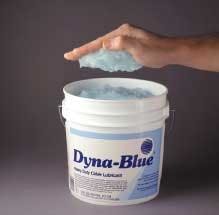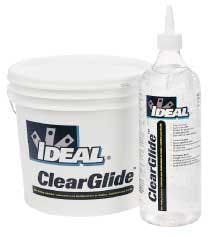Cable-pulling lubricants lower friction and pulling tension
Cable-pulling lubricants lower friction and pulling tension during a cabling installation, and help cable run smoothly over the surface of the conduit, preventing potential damage. "Too much friction can damage the cable jacket, and many problems and performance issues can result from excessive tension," says John Fee, president of American Polywater Corp. (polywater.com). "Smart lubricant usage ultimately saves money by potentially eliminating these problems, and installers should always use lubricants—it's good insurance and good practice.
Historically, cable-pulling lubricants have not been overly talked-about products—or at all revered, for that matter—among installers. In reality, most installers have not liked using lubricants for the simple fact that they add another time-consuming step in the cable-pulling process; and in the past, they have been messy and difficult to use.
American Polywater's DynaBlue is an everyday lubricant used for both electrical and communications cables.
null
"We've used many different lubricants, and we always come back to the newer ones that are easier to clean up and non-staining," says Ray Carroll, co-owner of All Electric Construction and Communications of Milford, CT. "When a lubricant works well and also doesn't make a mess, we can get in and get out." While cable compatibility and application are of the highest significance, convenience plays an important role in choosing one of the many types of available lubricants (see table, page 54).
Most lubricants are approximately 80 to 90% water plus other additives to create lubricity. Lubricant additives include wax, polymer, silicone, fluorinated ethylene propylene (FEP), or other chemicals specifically formulated for specific applications. The first pulling lubricants came on the scene more than 70 years ago for use with electrical cable, and consisted mostly of water and soap. The term "soap" is still common jargon used to refer to cable-pulling lubricant. But today's products are a far cry from those of yesteryear.
"Somewhere around the 1950s, we realized that the high pH level of soap had adverse effects on cable jackets, and that's when we started looking at more-neutral additives like wax," says Jim Washburn, product manager for Ideal Industries' (idealindustries.com) wire installation group. Wax-based lubricants, like Ideal's Yellow 77, cling to cable and do not readily wash away in water. "Over time, the water in the lubricant evaporates, leaving behind a residue," says Washburn. "With wax-based lubricants, that residue can become crusty and form a type of lattice between the cable and the conduit wall, which can affect cable removal 10 years down the road." According to Washburn, it may be difficult to break wax residue when removing cable; but once broken, the wax maintains some lubricity to help pull the cable out.
Wax-based lubricants do not appeal to the younger generation of installers, Washburn says, and neither are they the best option for indoor applications. "When communications cables came on the scene, we saw the introduction of polymer, silicon, and Teflon [FEP] additives, and most lubricants were enhanced for compatibility with all types of cable jackets," Washburn explains. "Polymer-based products are now the fastest-growing side of the business. They're easier to clean than wax-based products, which lets installers get into a building without worrying about making a mess."
Kristi Runser, tape and chemical product manager for Arnco Corp. (arncocorp.com), avoids offering wax- or petroleum-based lubricants, emphasizing the benefits of silicone. "The key is not to have something like wax that dries up and cakes so the cable and conduit become one, making it difficult to remove cable down the road," Runser says. "Silicone is a very slippery additive, and even when the water evaporates, it leaves behind a slick coating."
Other additives can include anti-freezing chemicals for winter-grade lubricants, and polymer-modified paraffin oil—a solid hydrocarbon mixture—for water-repellant lubricant. Water-repellant lubricant is ideal for pulling cable through water-filled ducts or porous conduit like concrete. Some manufacturers offer FEP-enhanced products, which further decrease friction for heavy-duty applications, such as long runs of heavy, larger-diameter cable.
Introduced in 1988, ClearGlide is a 100% clear polymer-based lubricant designed primarily for communications cable.
null
Right lube for the job
With the rise of the data-communications market and varieties of cable jackets emerging, many chemical manufacturers have introduced cable-pulling lubricants customized to the needs of indoor premises-cabling installers.
American Polywater's Premise Loop is a silicone-enhanced, colorless lubricant specifically formulated for compatibility and performance with communications cable jackets. "As fiber-optic and datacom cables started working their way into buildings, manufacturers approached us to study the coefficient of friction of these cable jackets and develop a specialty lubricant," Fee says. "
At the time, there were many differences among communications-cable jackets. Nowadays, these jackets have changed, making the cable easier to pull." Today, American Polywater sells small quantities of Premise Loop; according to Fee, it remains a premium choice for multiple bends and long runs.
Because the majority of cable-pulling lubricants serve the electrical contractor, Fee estimates that at least 80% of communications cable is pulled using readily available electrical lubricants. Such is the case with American Polywater's Dyna-Blue, an everyday lubricant often used among electrical and data-communications installers.
"Dyna-Blue is designed to be used in small quantities and applied by hand, which is common when pulls are short in length and have lower tension requirements," says Fee. "Dyna-Blue is easy to clean up and doesn't stain, which is beneficial in commercial and institutional environments, where we're dealing with finished walls, carpets, and suspended ceilings."
In 1988, Ideal Industries introduced ClearGlide, a clear, polymer-based lubricant designed primarily for communications cable. Available in quantities ranging from a 4-ounce bottle to a 5-gallon bucket, ClearGlide is designed to be safe for use on all types of cable, and offers easy cleanup.
Arnco's HydraLube F-150i and F-100i contain a stringy characteristic for use with optical-fiber, coaxial, and other communications cables. "Stringiness allows the lubricant to stream along with the cable as it's being pulled," says Runser. "When the lubricant doesn't stay with the cable, it's possible to lose lubrication after some distance." The F-150i is silicone-based to facilitate long pulls with multiple bends, while the F-100i is recommended for shorter, easier runs.
As part of a full line of electrical supply products, 3M (3m.com) offers WLC Wire-Pulling Lubricant Communication—a slow-drying, water-based liquid lubricant formulated for pulling communications cables. "The WLC is compatible with a broad range of jackets, and will not stress-crack low-density polyethylene," says Todd Vanden Branden, senior market development administrator. "These characteristics make WLC better for pulling communications cables rather than using lubes intended only for electrical."
For overhead cable pulls, 3M recommends a gel or wax-based lubricant such as the colorless, non-staining WL polymer gel, or WLX wax-based lubricant. "For hot environments, the wax-based lubricant is the best choice," says Vanden Branden. "It will not separate or liquefy with hot aging, and it maintains stability up to 194° Farenheit."
For outside, underground pulls of communications cable, manufacturers recommend lower-viscosity lubricants, which are generally pumped or poured into innerduct. P-T Technologies (pttech.com), a division of Illinois Tool Works, markets the Techlube line of lubricants, specifically formulated for outside-plant optical-fiber cable. Water-based polymer products, the Techlube line is available in a heavy-duty formula for larger-diameter cables and multiple bends and turns, and in an optical-fiber formula for smaller-diameter cables and straighter pulls.
All things considered
Manufacturers measure the lubricity of cable-pulling lubricants via the coefficient-of-friction value. Essentially, non-lubricated cables have a high coefficient, which is lowered with the use of a lubricant. "The coefficient of friction is dependent on the cable jacket, the conduit, the temperature, and several other testing variables," says American Polywater's Fee. "For example, today's premise jackets have an unlubricated coefficient of 0.3 at the low end and 0.7 at the high end. And when the conduit is concrete, that coefficient is typically over 1.0."
According to Fee, the right lubricant can lower the coefficient of friction to 0.1 or lower. But it's important to consider all variables, including run length, cable weight, and number of angled bends.
All cable manufacturers specify maximum allowable tension depending on the cable type. The maximum allowable tension is the greatest force that can be applied to a cable during installation without damaging it, and those numbers can vary greatly, from as little as 25 pounds to more than one ton. "Premise cables normally have low maximum-allowable tensions, and it's more common for them to pass through a series of bends," says Fee. "Even with a short run, and a maximum tension as low as 25 pounds (which can easily be pulled with a single arm), it's not wise to pull communications cable without lubricant."
According to Fee, it's imperative for installers to know their cable's tension specifications, and to remember that the number and angle of bends can change those specifications dramatically. "Only when all the data is available can the decision be made on which lubricant, if any, to use," says Fee.
With so many different jacket types in use, installers should establish that the lubricant they choose is compatible with the cable type. "Some greases and soaps can actually swell plastic and cause them to crack, which has adverse effects and can be a costly mistake," says Fee. "Installers are concerned about time and money, and if they don't use the right lube, it can cost them more money in the long run."
Concludes Ideal's Washburn, "I don't envision all cable-pulling lubricants becoming clear and stain-free, because in some cases, that can add cost—especially on large jobs. But we're going to see more manufacturers move toward offering lubricants that provide easy applications and cleanup. Because when the user is the chooser, they will choose convenience."
Betsy Ziobron is a freelance writer covering the cabling industry.
download pdf of table from pg. 54 "Product Update: Cable Pulling Lubricants"

